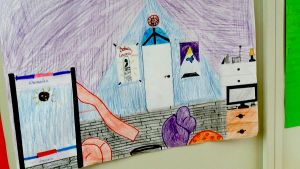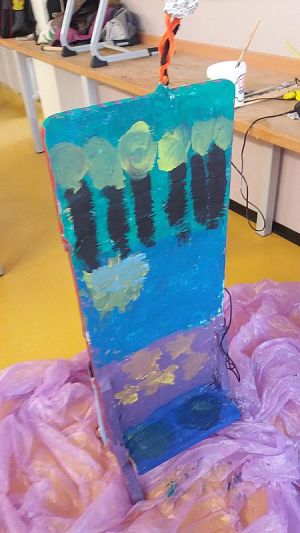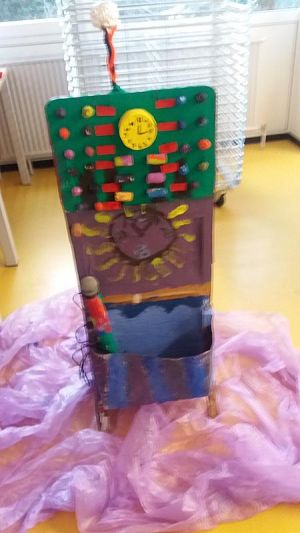Storyline
We will publish the outcomes of the Storyline "Our Time Machine" under this button. You can find theory, practice and results for downloading. There will be a handbook at the end of the project. We will also use the planning method "Understanding by Design" for the storyline.
Storyline
"Our Time Machine"
written for the Erasmus+ Projekt
"From Papyrus to Stonepaper and beyond - the Questions behind"
2016 - 2018
Partners
Grundschule im Beerwinkel, Berlin, Germany
Gesamtschule Maarja Magdalena / Estonia
Szkola Podstawowa Nr 1, Barlinek/ Poland
Allgemeinbildende Mittelschule Nr. 2, Kobrin, Belarus
13ο HIGHSCHOOL OF KALLITHEA 'SOKRATES' / Athens / Greece
ISTITUTO COMPRENSIVO CANTU´1, Cantu / Italy
Colegio Torrente Ballester Parla/ Spain
Resat Turhan Ortaokulu Izmir / Turkey
The Edinburgh Academy Junior School / Edinburgh / Scotland
De Noordwijkse School / Noordwijk / Holland
University Buca / Izmir/ Turkey
Ursula Ondratschek
Grundschule im Beerwinkel
Im Spektefeld 31
13589 Berlin
ullaon@penticom.de
How to create a storyline
Example: Our Time Machine
Copyright: Ulla Ondratschek
Please choose what you might need. The order is tested but you can change it, of course.
1. Introduce a New Identity
- let the children find a new name, a profession, a new town and street they live in, a new age.
Worksheets
ID-cards, list of: surnames, forenames, jobs, streets, (towns can be found in an atlas or map)
2. Make photos with a special item they choose
(special agent = sunglasses etc) and produce an ID-Card. The children have to show the ID-Card to enter the classroom during English lessons and put on their special item. This is for "entering" the storyline. The teacher also should have a new ID and a special item.
My name is: I am a/an I come from I am years old. |
 |
3. Work a bit with the new names and ID's
- (so that everybody knows each other, especially the teacher!)
- Good methods are:
- guessing games
- interviews, small talk
- describing the neighbour
- making posters and hang them up
- making a word bank with important words
- take notes - let one child introduce itself at the beginning of the lesson, the others take notes and collect them in a folder
Make a bigger poster
My ……………………………………………………………… forename / surname)
I ……………………………………………………………………………………… (job)
I ………………..…………………………………………………………. (country/town)
I …………………………………………………………………….. (age )
Help: Look at Mrs Miller's poster!
Worksheets
32 questions, small talk, New ID (easy and difficult) wordlist, word bank, example of poster, take notes - blank
4. Children create more about the New ID
Worksheets:
mindmap, About myself (easy / difficult), How to describe a person,
Mindmap:
find words to the topics:
family, job, house, hobbies, looks, town ….
Example: About myself
My name is Alice Miller. I am 51 years old.
I am blonde and tall. I wear my hair in a pony tail.
I am 1.80 m tall. I am slim.
I have got long legs. My eyes are blue and my ears are small.
I have a normal nose and full lips.
5. Children create a 7- page - booklet about themselves:
- As a "ticket" to enter the time machine they have to write/ draw and tell about themselves .They will make a little booklet from patterns and suggestions provided by the teacher (grids)
- Word fields: body, looks, family, jobs, free time, school…
Worksheets:
About myself (sample of the teacher),
grids for 7 pages,
Word lists for each page,
tasks for station work,
survey- chart,
blank wordlist for "Own Wordlist" ),
main words- wordlist for learning by heart , word bingo and tests,
GRIDS (see material)
to talk about people 1/2/3/4/5/6/7
to write about people
to make up new identities
Class ……: station work "Our Time machine" - writing a booklet. Who has done what already:
|
names |
1 |
2 |
3 |
4 |
5 |
6 |
7 |
8 |
|
|
|
|
|
|
|
|
|
|
|
|
|
|
|
|
|
|
|
|
|
|
|
|
|
|
|
|
|
|
|
|
|
|
|
|
|
|
|
|
|
|
|
|
|
|
|
|
|
|
|
|
|
|
|
|
|
|
|
|
|
|
|
|
|
|
|
|
|
|
|
|
|
|
|
|
|
|
|
|
6. TIME for 1st class-test!
Play WORD BINGO before: teacher and children have the same wordlist. Children write down 9 English words in 2 minutes time. Then the wordlist has to be hidden. Teacher writes words from the list by random in the home language on blackboard. Children check their words and tick them off. If one has ticked all 9 words it shouts "Bingo". Teacher checks the spelling (it has to be completely right) and declares the winner.
|
|
|
|
|
|
|
|
|
|
|
|
Worksheets: Example of class-test / BINGO Chart
Suggestions for the class test:
Listening:
Listen to a text about looks and hobbies (maybe from an English school book)
Writing:
Write 20 words from your own word - list into a mindmap
Write 10 sentences about your New ID (you can prepare it at home but not use the notes)
Reading: Read the text about Mrs Miller and tick off the right box: right, wrong-not in the text.
7. Together with the Arts- and/or Turkish teacher the children create a Time machine
This can be made from recycling material, paper maché, fabrics…. It can be small or big . It gets a permanent place in the class room.
8. Before starting the Time Machine the children create their own rooms in the Time Machine
(word field: room, furniture, toys, equipment …)

In their room they need something special to differentiate it from other rooms, make it interesting - like a slide or a shark in the swimming pool.
They draw a poster of their room, make a wordlist with all the things and present it in front of the class. For differentiation you can give the children a grid or they can write their own sentences about their rooms. They can work alone or in pairs.
9. Take the sentences about the rooms and make a Guided Imagery in the time machine
Write a text about the rooms and read it to the children while they close their eyes and listen intently. Then ask them what they understood: words, sentences, whole passages…
Hand out the text and let them work a bit on it: reading to their neighbours, finding out unknown words, for good students: write your own guided imagery of your room !
Worksheets: Create your room, Guided imagery,

10. Have a celebration
The opening of our Time Machine !
- Make it small (only the class) or big (with guests) - set up all posters , the Time Machine
- Let the children write an invitation for the guests
If you like: invite other classes, parents, teachers, press … provide balloons and decoration and maybe something to eat and drink - involve the parents - have an official opening with music and speech - Let the children introduce their rooms in the foreign language.
11. Life in the Time Machine
After the opening celebration introduce more and more situations and patterns to the children about all kinds of stories.
For instance: The breakfast buffet
Be the captain and describe the buffet in an empty corner of the classroom. Take things the children already know. Make a plan first: Where are the tea, coffee, rolls, marmalade, full English breakfast….. Use their imagination. Ask them questions like: Oh, I forgot - where was the tea? The children will show you the exact place you pointed to!
Follow up tasks:
Let them write down the breakfast words, draw a picture of the buffet, favourite words , small talks, make a real breakfast with them: Toast, baked beans, marmalade…)
More topics can be:
- drinks and food for lunch and dinner,
- cleaning the rooms
- meeting in the library and learning about history
12. Time to use the time machine going into time!
The main idea is that you can use the time machine to visit ancient or other times - connecting history, geography, arts, Turkish, biology, etc. in a CLiL approach.
There is a lot of material available in the internet for downloading or books to order if necessary at Amazon.
Examples:
Reading books of a well known author in English (maybe Julia Donaldson and the Gruffalo or other children's books)
The children can invent situations themselves: meeting the author or the characters of the book, asking them questions, presenting their books, getting drawn into the adventures……
Or:
Going to old Egyptian times and talk and read about the pharaoh, papyrus, slaves, the Nile……
Going to the Zoo and learn about the animals
Having an outing into the countryside of medieval Turkey…
There are many opportunities and topics!
After the opening celebration introduce more and more words and patterns to the children about all kinds of stories.
Use your English book as well. Here are some suggestions:
- Travel times for the time machine: learn the numbers / times. Make it simple at first : full hours
- Colours: teach the colours and let the children describe their posters
- Centuries : learn the numbers and the names for century, millennium etc) make it simple again, using round lots
- Birthday: one of the owners has birthday and there is a birthday party going on in the time machine. Use the range of words for party and celebration
- Going on a flight: create a dialogue between the captain and the traveller - use a simple time travel to an important event (methods: play it yourself with a good pupil, whisper the dialogue to the acting children, let them read and fill in a prepared dialogue, use the real things - children bring items or material from home…) ,
- an incident / accident:
wrong timing - wrong century
dinosaurs
meeting children in other times - school/ reading/ illiterate/ food
- Festivals in the time machine
- a famous guest in the time machine
cleaning, redecorating - information about the famous guest
writing articles about the flights into time ( past tense!)
- write/speak about your adventures
- making rhymes or poems about your adventures (rap, songs…)
- …
More ideas for storyline places:
On the ship
In a hotel
In a cafe
At the hospital
At the airport
At a boarding school
In a holiday camp
Afterthoughts
- Can you imagine to use parts or the whole storyline in your class room?
- Which parts are the most practicle and easiest ones for your teaching?
- Could you work with other teachers in the team?
- What obstacles would you name not to start a story line?
- ____________________________________________________
- ____________________________________________________



Comments
Comment by Dustin |
This picture is cool.